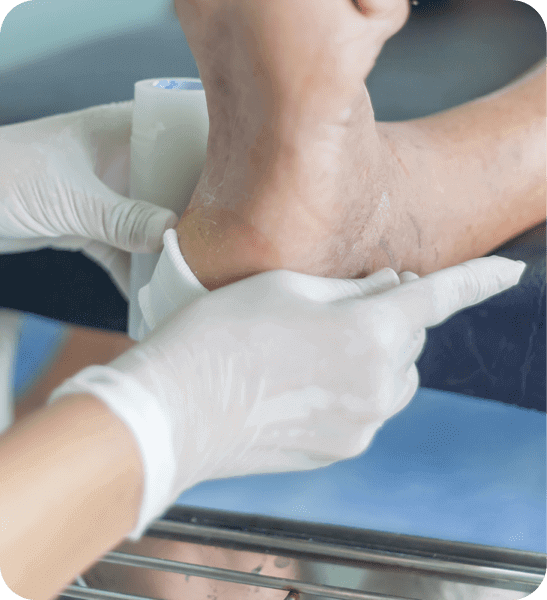Hyperbaric Oxygen Therapy: A Vital Treatment for Decompression Sickness as well as Air and Gas Embolisms

How Hyperbarics Helps
Reduces bubble size and volume
Enhances oxygen delivery
Counteracts ischemic injury
Accelerates nitrogen removal
Supports neovascularization
Reduces inflammation
Reduces ischemia-reperfusion injury
What the Research Says
Decompression sickness (DCS), commonly known as "the bends," is a potentially debilitating condition affecting divers who surface too quickly or fail to adhere to proper decompression procedures. The rapid reduction in pressure leads to the formation of gas bubbles in the body, causing a myriad of symptoms ranging from joint pain and fatigue to more severe neurological and cardiopulmonary complications. Hyperbaric oxygen therapy (HBOT) has emerged as a pivotal treatment for DCS, helping to alleviate symptoms and promote healing. This article explores the mechanism of HBOT and its effectiveness in managing decompression sickness.
Understanding Decompression Sickness, Air and Gas Embolisms
Decompression sickness occurs when dissolved gases, primarily nitrogen, come out of solution and form bubbles in the body due to rapid changes in pressure. These gas bubbles can cause mechanical, embolic, or biochemical effects, leading to a variety of symptoms, including joint pain, dizziness, shortness of breath, extreme fatigue, and in severe cases, paralysis or death.Similarly, Air and gas embolisms occur when gas bubbles, usually air or nitrogen, enter the bloodstream and obstruct blood flow in blood vessels. This blockage can lead to tissue hypoxia, inflammation, and damage, with symptoms ranging from mild discomfort to severe neurological and cardiopulmonary complications. The severity and location of the embolism dictate the patient's symptoms and overall prognosis.
Hyperbaric Oxygen Therapy: A Lifesaver for DCSHyperbaric oxygen therapy is a medical treatment that involves placing the patient in a chamber with pressurized oxygen. The increased atmospheric pressure allows for higher oxygen concentrations in the blood, which aids in the healing process.
Hyperbaric Oxygen Therapy: A Lifesaver for DCSHyperbaric oxygen therapy is a medical treatment that involves placing the patient in a chamber with pressurized oxygen. The increased atmospheric pressure allows for higher oxygen concentrations in the blood, which aids in the healing process.
- Reducing Bubble Size and Volume: The primary mechanism of HBOT in treating air and gas embolisms involves reducing the size of gas bubbles within the bloodstream. By increasing the pressure in the chamber, the gas bubbles shrink, reducing their potential to obstruct blood flow. This decrease in bubble size allows them to be reabsorbed into the bloodstream and subsequently eliminated through the respiratory system.
- Enhancing Oxygen Delivery: HBOT increases the amount of dissolved oxygen in the blood, improving oxygen delivery to tissues affected by the embolism. The increased oxygen supply promotes healing, reduces inflammation, and mitigates the effects of ischemia (lack of oxygen) in the affected tissues
- Counteracting Ischemic Injury: Gas embolisms can lead to ischemic injury, which occurs when tissues are deprived of oxygen due to reduced blood flow. HBOT counteracts ischemic injury by increasing the oxygen concentration in the blood, ensuring that tissues receive adequate oxygen for healing and reducing the risk of permanent damage.
- Accelerating Nitrogen Elimination: HBOT helps expedite the elimination of nitrogen from the body. By increasing the oxygen concentration in the blood, the rate of nitrogen elimination is accelerated, as the body works to restore a normal balance of gases. This rapid removal of nitrogen helps to dissolve any remaining gas bubbles, further reducing symptoms and complications of decompression sickness.
- Supporting Neovascularization: HBOT has been shown to promote neovascularization, the formation of new blood vessels in response to tissue injury. This process can help restore blood flow to areas affected by gas embolisms, further supporting tissue recovery and reducing long-term complications.
- Reducing Inflammation: Inflammation often occurs in response to air and gas embolisms, contributing to tissue damage and exacerbating symptoms. HBOT has been demonstrated to reduce inflammation by inhibiting the production of pro-inflammatory cytokines and increasing the production of anti-inflammatory mediators, supporting the healing process.
- Reducing Ischemia-Reperfusion Injury: In some cases, the gas bubbles in the blood vessels can lead to ischemia, a condition where tissues are deprived of oxygen due to reduced blood flow. Upon the restoration of blood flow, the affected tissues may experience reperfusion injury, characterized by inflammation and oxidative damage. HBOT has been shown to reduce the severity of ischemia-reperfusion injury by enhancing oxygen delivery and reducing inflammation.
Hyperbaric oxygen therapy has proven to be an indispensable tool in the treatment of decompression sickness, significantly improving patient outcomes. In addition, it has proven to be a valuable treatment option for air and gas embolisms. By reducing bubble size and volume, enhancing oxygen delivery to tissues, accelerating nitrogen elimination, and reducing ischemia-reperfusion injury, HBOT plays a crucial role in healing and recovery. While HBOT is an effective therapy, it is essential to remember that prevention is always the best approach. Ensuring proper diving practices, following medical procedure guidelines, and promptly seeking medical attention for traumatic injuries can help minimize the risk of air and gas embolisms.
Research Studies
Early hyperbaric oxygen therapy is associated with favorable outcome in patients with iatrogenic cerebral arterial gas embolism
Early hyperbaric oxygen therapy is associated with favorable outcome in patients with iatrogenic cerebral arterial gas embolism
A retrospective review of 656 cases showed that patients treated with HBOT had a significantly higher rate of full recovery
A retrospective review of 656 cases showed that patients treated with HBOT had a significantly higher rate of full recovery
HBOT reduces the size of gas bubbles and enhances their absorption, effectively restoring normal blood flow and oxygenation to affected tissues
HBOT reduces the size of gas bubbles and enhances their absorption, effectively restoring normal blood flow and oxygenation to affected tissues
Patient Experiences
-

Lisa, 44
After seven years of suffering, hyperbaric oxygen therapy healed her osteomyelitis.
Lisa St John, the clinic director for Bay Area Hyperbarics, had chronic refractory osteomyelitis that lasted seven years with no relief. The infection induced severe fatigue and cognitive impairment that prevented her from working, and required her to sleep up to 18 hours per day. Finally, a physician recommended hyperbaric oxygen therapy with antibiotics, which after 60 treatments, healed her. Shortly after being healed, she sold her home to begin her first hyperbaric oxygen therapy clinic, which she has owned for almost 25 years!
-

Jennifer, 68
Hyperbaric oxygen therapy eliminated the need for surgery to heal her bone infection.
Jennifer had osteomyelitis of the lower jaw (mandible), which proved difficult to heal. Her teeth were becoming loose, and her doctor thought she would need surgery. However, he prescribed hyperbaric oxygen therapy before the surgery, and after 60 treatments, her chronic refractory osteomyelitis healed completely, regrowing bone in her mandible. Jennifer was able to keep her teeth, and was able to return to her active lifestyle, hiking regularly with her husband.
Physicians: Refer a Patient
You Submit Your Patient’s Information
We Get Authorizations
Patient Starts HBOT

Related Articles
Research on Hyperbaric Oxygen Therapy
-
What is Hyperbaric Oxygen Therapy?
Hyperbaric oxygen therapy treats medical conditions with 100% oxygen in a pressurized hyperbaric chamber. The patient lies or sits in the chamber. The oxygen then saturates the plasma in the blood, allowing oxygen to easily flow throughout the body and reach even areas that are injured or diseased, which typically receive less oxygen. The mechanisms of hyperbaric oxygen therapy include stimulating and mobilizing stem cells, down-regulating inflammatory genes, up-regulating reproductive cells and stimulating DNA. HBOT also regrows tiny blood vessels, and stimulates the growth of new healthy cells in the brain, bones, skin, organs, and tissues. People seek hyperbaric oxygen therapy to heal physical damage in their bodies and to promoting health and anti-aging.
-
Does HBOT kill cancer cells?
Current research indicates that hyperbaric oxygen does not kill cancer cells. However, there has been a small amount of research indicating that hyperbaric oxygen might reduce the size of certain tumors. Also, there has been a study on mice using hyperbaric oxygen, along with a ketogenic diet, to reduce tumors. Hyperbaric oxygen causes many different healing modalities to kick into gear. Could its effect on strengthening the immune system inhibit the growth of cancer cells? Nobody knows. There are numerous studies conclusively showing that hyperbaric oxygen does not encourage cancer cells or tumors to grow. Some patients claim the hyperbaric oxygen makes them feel a lot more comfortable and functional after chemotherapy and also during healing. Note that some chemotherapy drugs are not to be used with hyperbaric oxygen, as the chemotherapy drugs can be enhanced and thus become toxic. A good hyperbaric oxygen facility (such as Bay Area Hyperbarics) will always call the chemotherapy manufacturer to ensure that hyperbaric oxygen therapy will be helpful and not damaging to the patient.
-
IWhat is the CPT code for HBOT?
The CPT code for HBOT is G0277.
-
Does Medicare cover HBOT?
Medicare covers Hyperbaric Oxygen Therapy for approved conditions, and many insurance companies also cover approved conditions. If your condition is not approved by your insurance, we can discuss our special rates. Give us a call at (408) 356–7438. We are happy to discuss your options with you.
-
Can HBOT help Neuropathy?
Hyperbaric treatments help heal neuropathy by regrowing small blood vessels and nerves that have died from disease, injuries from radiation and aging. Patients often experience numbness and or pain when they start treatment. Hyperbaric treatments most often bring back sensation and make, for example, walking easier and more enjoyable.
-
Why would a physician consider HBOT?
A physician would consider using hyperbaric chamber therapy under a variety of situations. Physicians most typically refer patients to hyperbarics when the patient is not healing with traditional medical interventions and hyperbaric chamber therapy is approved by Medicare for this condition. Some patients experience significant unresolved pain and unremitting disease states that the mechanisms of hyperbaric oxygen therapy in a hyperbaric chamber are known to affect, such as the down regulation of inflamatory genes. For an example, some patients have experienced severe, unremitting hives with itching, which did not improve with any specialists interventions. Some physicians will consider hyperbaric chamber therapy if the patient has no other good avenues for improving their failing health, and they know the hyperbaric chamber therapy is safe and will not harm the patient.
-
What is Hypebaric Oxygen Therapy?
Hyperbaric Oxygen Therapy (HBOT) Hyperbaric Oxygen Therapy (HB0T) is a medical treatment where you inhale 100% oxygen in a chamber with increased atmospheric pressure. HBOT injects 400x the oxygen into your tissues and bones and mobilizes stem cells. It regrows healthy tissues in the brain, blood vessels, skin and bones. It also reduces pain and swelling, and speeds recovery. It is simple, effective and painless.
Have more Questions?




